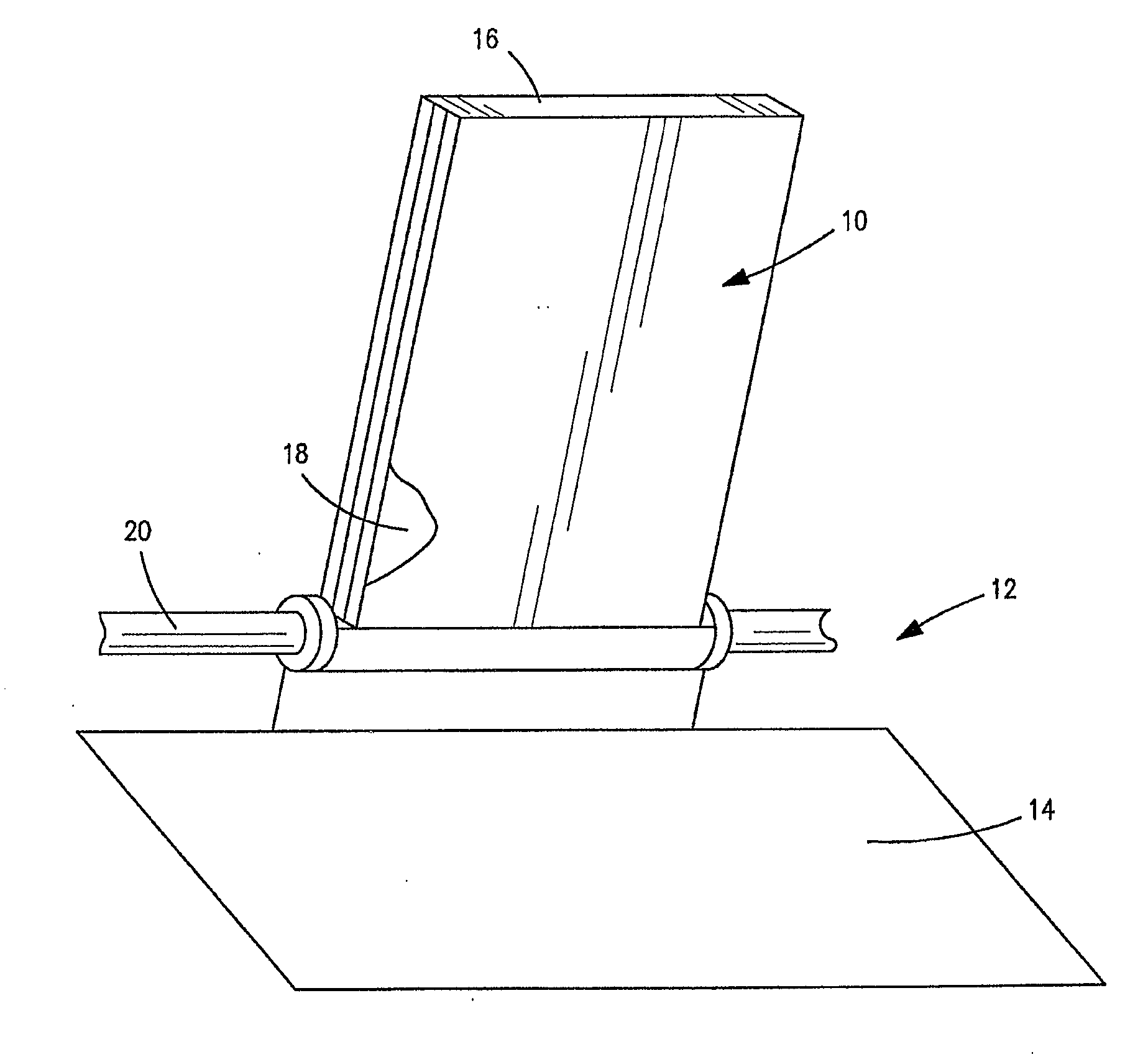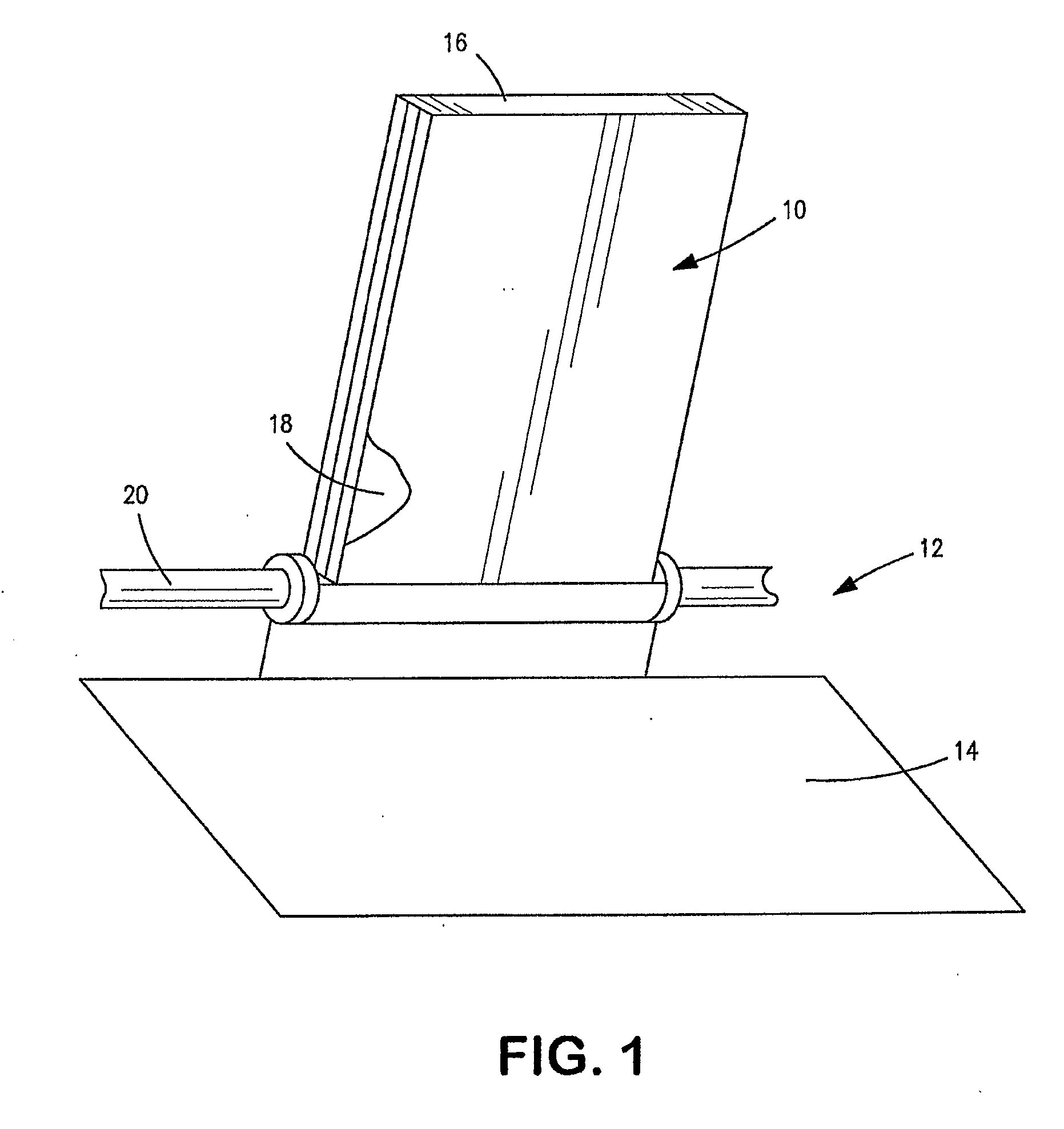Surface For A Food Preparation Device
a technology for food preparation devices and surfaces, which is applied in the directions of milk preservation, transportation and packaging, cooking vessels, etc., can solve the problems of poor mechanical properties, deterioration of the easy release quality of ptfe, and more susceptible to scratching of spray and bake coatings than ptfe sheets, etc., to achieve easy removal and replacement, high density, and high tensile strength
- Summary
- Abstract
- Description
- Claims
- Application Information
AI Technical Summary
Benefits of technology
Problems solved by technology
Method used
Image
Examples
example 1
[0037]In this example, as described in more detail below, loose covers for the upper surface of a clamshell grill (Garland Electric Xpress Grill, Model XE24, Garland Commercial Industries, Freeland, Pa.) were designed with one folded and bonded edge. This edge created a tunnel through which an aluminum rod was inserted. The rod was longer than the sheet and was used to attach the sheet to the rear of the clamshell. The front of the sheet was attached to the grill surface by two clips which simply held the sheet in place using friction.
[0038]A sheet of dense, high tensile strength ePTFE was obtained measuring approximately 22 inches (56 cm) by 19 inches (48 cm) by 0.003 inch (0.076 mm) thick and having the following properties: density of 2.1 g / cc, tensile strength in two orthogonal directions of at least 20,000 psi (138,000 KPa), thermal resistance of about 1.48° C.-in2 / W, a tear resistance of 1.9 lbs / mil in the strongest direction and 1.6 lbs / mil in the orthogonal direction. One ed...
example 2
[0043]A cooking surface was fabricated as described in Example 1, except that the starting material was a sheet of dense, high tensile strength ePTFE measuring approximately 22 inches (56 cm) by 19 inches (48 cm) by 0.0003 inch (0.0076 mm) thick and having the following properties: density of 2.1 g / cc, tensile strength in two orthogonal directions of at least 15,000 psi (103,000 KPa), thermal resistance of about 0.45° C.-in2 / W, a tear resistance of 1.5 lbs / mil in the strongest direction and 0.67 lbs / mil in the orthogonal direction.
[0044]The device was installed on one of the two upper platens of the clamshell grill, and a commercially available release sheet (Teflon Release Sheet, Part # 1799303, Taconic, Inc., Petersburgh, N.Y.) was installed on the other upper platen. Hamburgers were cooked under the same conditions (temperature, gap, pressure, time) using both the commercial release sheet and the sheet of the present invention to demonstrate performance of the grill cover device....
example 3
[0045]A stainless steel plate useable as a cooking surface with an easy release surface of the present invention was fabricated by the following technique.
[0046]A laminated sheet of dense, high tensile strength ePTFE with a PFA adhesive on one side was obtained measuring approximately 4 inches (10 mm) by 4 inches (10 mm) and 0.002 inches (0.05 mm) thick, and having the following properties: PTFE density of 2.1 g / cc, PTFE thickness of about 0.0018 inch (0.046 mm), laminate tensile strength in two orthogonal directions of at least 9000 psi, thermal resistance of about 1.088° C.-in2 / W, a tear resistance of 1.1 lbs / mil in the strongest direction and about 0.16 lbs / mil in the orthogonal direction.
[0047]A 304 stainless steel plate measuring about 1 / 16 inch thick was cut to 4 inches by 4 inches, as shown in FIG. 3 as 25. The plate was cleaned in a hot soap bath, followed by a hot water rinse. The plate was cleaned again with 1,1,2 trichlorotrifluoroethane and 99.9% pure isopropanol with le...
PUM
 Login to View More
Login to View More Abstract
Description
Claims
Application Information
 Login to View More
Login to View More - R&D
- Intellectual Property
- Life Sciences
- Materials
- Tech Scout
- Unparalleled Data Quality
- Higher Quality Content
- 60% Fewer Hallucinations
Browse by: Latest US Patents, China's latest patents, Technical Efficacy Thesaurus, Application Domain, Technology Topic, Popular Technical Reports.
© 2025 PatSnap. All rights reserved.Legal|Privacy policy|Modern Slavery Act Transparency Statement|Sitemap|About US| Contact US: help@patsnap.com



